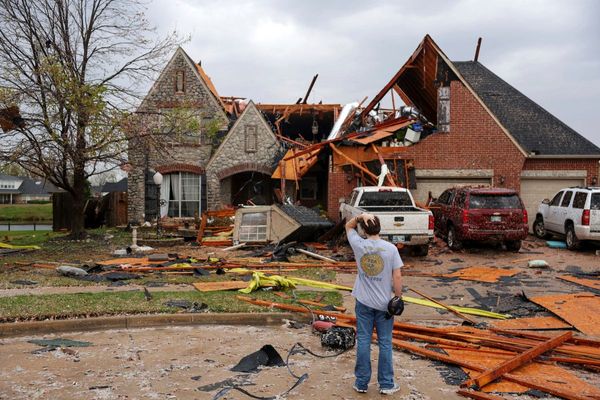The US and UK have launched airstrikes on more than a dozen sites used by the Iranian-backed Houthis in Yemen, according to US officials. More information on the strikes can be found here.
The strikes are the most significant military response to the Houthis’ persistent campaign of drone and missile attacks on commercial ships in the Red Sea, which began after Israel’s war in Gaza broke out. Here’s how we got here:
Who are the Houthis?
The Houthis are a Yemeni militia group named after their founder, Hussein Badreddin al-Houthi, and representing the Zaidi branch of Shia Islam. They emerged in the 1980s in opposition to Saudi Arabia’s religious influence in Yemen. The group, which has an estimated 20,000 fighters and whose official name is Ansar Allah, runs most of the west of the country and is in charge of its Red Sea coastline.
What is the group’s relationship with Iran and the war in Gaza?
The Houthis are backed by Iran as part of its longstanding hostility with Saudi Arabia and are supporting Hamas in the war in Gaza. Soon after the Hamas massacre on 7 October, the Houthi leader Abdul Malik Al-Houthi said his forces were “ready to move in the hundreds of thousands to join the Palestinian people and confront the enemy”.
What has been happening in the Red Sea?
The Red Sea, one of the world’s most densely packed shipping channels, lies south of the Suez canal, the most significant waterway connecting Europe to Asia and east Africa. Yemen is situated along the sea’s south-east coast, where it meets the Gulf of Aden.
Shortly after the start of the Gaza war the Houthis began launching missile and drone attacks at vessels in the Red Sea, most of which were intercepted by US and Israeli countermeasures.
The situation escalated on 19 November, when militants used a helicopter to seize a car carrier chartered by a Japanese company and linked to an Israeli businessman, abducted the crew. The Houthis said all vessels they perceived as linked to Israel or its allies would “become a legitimate target for armed forces”.
Multiple attacks on vessels followed, mostly without success, but many shipping companies nevertheless decided to bypass the Red Sea route and divert around South Africa’s Cape of Good Hope, significantly adding to journey times and cost.
How has the US responded?
On 18 December the US announced the formation of Operation Prosperity Guardian in response to the Houthi attacks.
The US refrained from direct confrontation until 31 December, when US Navy helicopters fired on a group of small boats attempting to board a container ship that had requested their protection. The deaths of 10 militants marked a new phase in the crisis.
On 9 January US and British warships shot down 21 drones and missiles fired by the Houthis, in what London called the largest such attack in the area. On 10 January, Antony Blinken, the US secretary of state, said further attacks could prompt a western military response.
What was happening in Yemen before the Gaza war?
The Houthis had been gaining support around the turn of the century from Shia Yemenis fed up with the corruption and cruelty of the longtime authoritarian president and Saudi ally, Ali Abdullah Saleh, particularly during the aftermath of 9/11 and the US invasion of Iraq. Popular protests and several assassination attempts forced Saleh to resign in 2012.
In 2014 the Houthis allied with their former enemy Saleh to seize the capital, Sana’a, and overthrew the new western-backed president, Abd Rabbu Mansour Hadi, a year later. After Hadi was forced to flee, the exiled Yemeni government asked its allies in Saudi Arabia and the UAE to launch a military campaign, also backed by the west, to drive out the Houthis.
A catastrophic civil war ensued that the UN estimated led to 377,000 deaths and displaced 4 million people by the end of 2021.
The Houthis in effect won the war. An April 2022 ceasefire prompted a significant decline in violence, and fighting has largely remained in abeyance despite the official expiry of the truce in October.
How were the attacks by the Houthis seen in Yemen and Saudi Arabia?
Some Yemenis see the Houthi operations as a legitimate means of exerting pressure on Israel and its allies in defence of Palestinian civilians, and analysts say the Houthis’ intervention has helped shore up their domestic support. The militants also believe attacks in the Red Sea can make them a more significant global player, synonymous with Yemen as a whole despite the presence of an internationally recognised government in the south of the country.
Meanwhile, the Saudis are attempting to normalise relations with Iran, and finalise a peace deal that could recognise Houthi control of the north of Yemen. They have been anxious about any response from the US that could complicate its effort to withdraw from the country.
More information
Visual guide: What has been hit and where in Yemen?
Regional response: Hezbollah and Iran condemn US and UK
Analysis: Strikes could bring Biden closer to the regional war he sought to avoid







